Genetics Report: DNA Structure, Replication, Meiosis and Mitosis
VerifiedAdded on 2020/06/04
|7
|1316
|79
Report
AI Summary
This report provides a comprehensive overview of genetics, focusing on DNA structure, chromosomes, and genes. It delves into the mechanism and significance of DNA replication, explaining the process as semi-conservative and highlighting the role of cellular proofreading. The report further explores the events of meiosis and mitosis, comparing their products and emphasizing the significance of meiosis in generating genetic variation. The structure of DNA, composed of four bases (guanine, cytosine, adenine, and thymine), is discussed, as well as the role of chromosomes and genes within cells. The report concludes by summarizing the importance of these processes in the context of biological inheritance and genetic diversity. The report also includes a diagram illustrating the structure of DNA, chromosomes, and genes, referencing the U.S. National Library of Medicine (2018) as the source.

Task 23 - Genetics
Paraphrase This Document
Need a fresh take? Get an instant paraphrase of this document with our AI Paraphraser
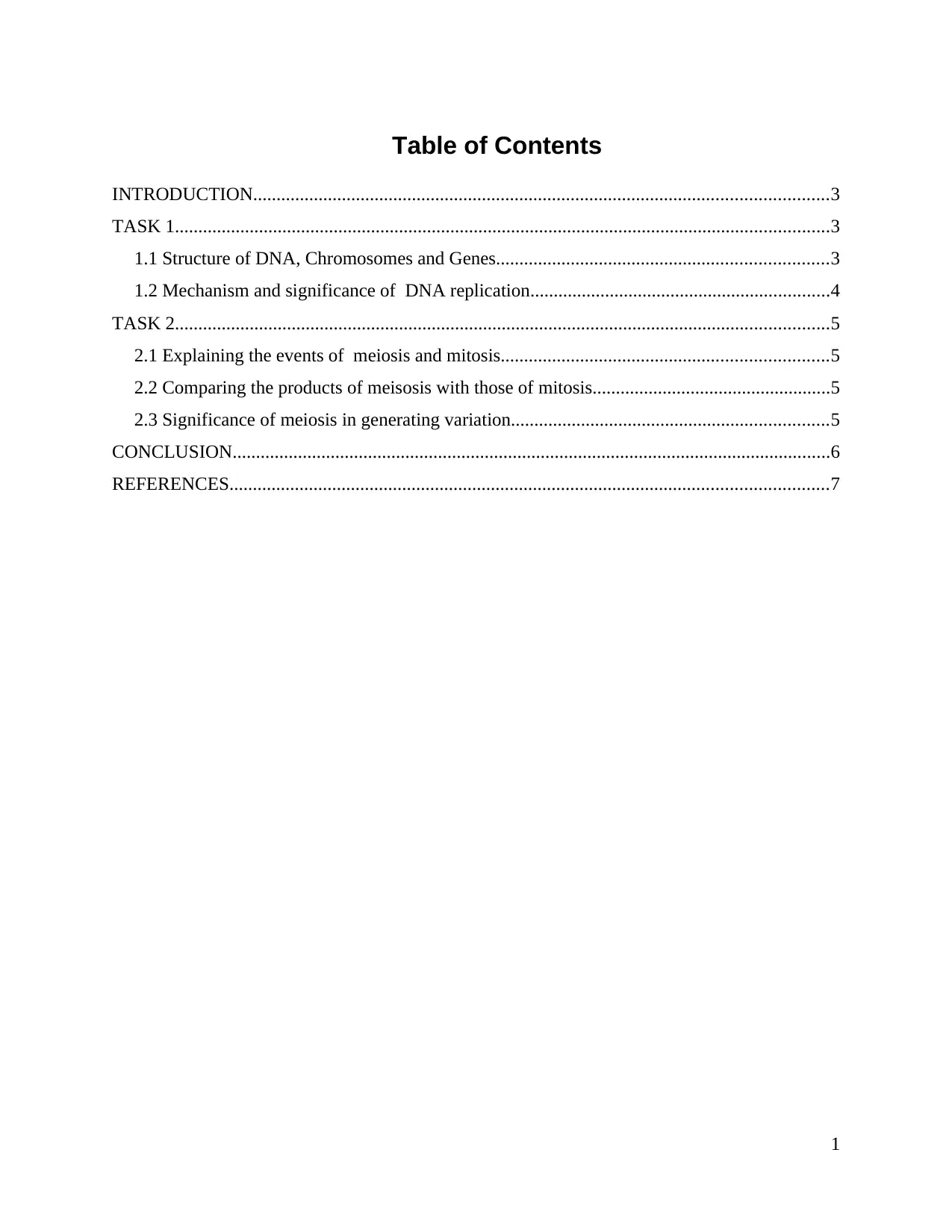
Table of Contents
INTRODUCTION...........................................................................................................................3
TASK 1............................................................................................................................................3
1.1 Structure of DNA, Chromosomes and Genes.......................................................................3
1.2 Mechanism and significance of DNA replication................................................................4
TASK 2............................................................................................................................................5
2.1 Explaining the events of meiosis and mitosis......................................................................5
2.2 Comparing the products of meisosis with those of mitosis...................................................5
2.3 Significance of meiosis in generating variation....................................................................5
CONCLUSION................................................................................................................................6
REFERENCES................................................................................................................................7
1
INTRODUCTION...........................................................................................................................3
TASK 1............................................................................................................................................3
1.1 Structure of DNA, Chromosomes and Genes.......................................................................3
1.2 Mechanism and significance of DNA replication................................................................4
TASK 2............................................................................................................................................5
2.1 Explaining the events of meiosis and mitosis......................................................................5
2.2 Comparing the products of meisosis with those of mitosis...................................................5
2.3 Significance of meiosis in generating variation....................................................................5
CONCLUSION................................................................................................................................6
REFERENCES................................................................................................................................7
1
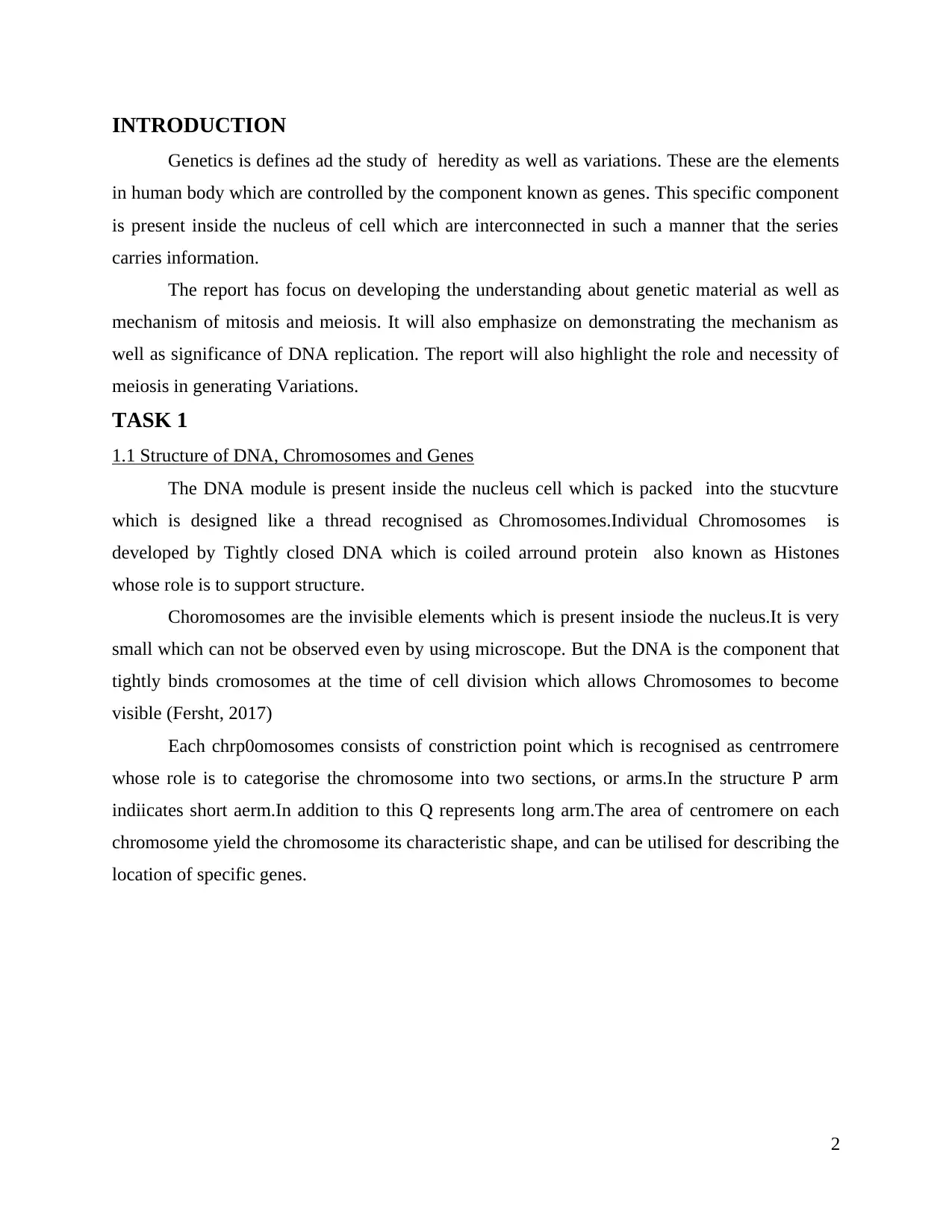
INTRODUCTION
Genetics is defines ad the study of heredity as well as variations. These are the elements
in human body which are controlled by the component known as genes. This specific component
is present inside the nucleus of cell which are interconnected in such a manner that the series
carries information.
The report has focus on developing the understanding about genetic material as well as
mechanism of mitosis and meiosis. It will also emphasize on demonstrating the mechanism as
well as significance of DNA replication. The report will also highlight the role and necessity of
meiosis in generating Variations.
TASK 1
1.1 Structure of DNA, Chromosomes and Genes
The DNA module is present inside the nucleus cell which is packed into the stucvture
which is designed like a thread recognised as Chromosomes.Individual Chromosomes is
developed by Tightly closed DNA which is coiled arround protein also known as Histones
whose role is to support structure.
Choromosomes are the invisible elements which is present insiode the nucleus.It is very
small which can not be observed even by using microscope. But the DNA is the component that
tightly binds cromosomes at the time of cell division which allows Chromosomes to become
visible (Fersht, 2017)
Each chrp0omosomes consists of constriction point which is recognised as centrromere
whose role is to categorise the chromosome into two sections, or arms.In the structure P arm
indiicates short aerm.In addition to this Q represents long arm.The area of centromere on each
chromosome yield the chromosome its characteristic shape, and can be utilised for describing the
location of specific genes.
2
Genetics is defines ad the study of heredity as well as variations. These are the elements
in human body which are controlled by the component known as genes. This specific component
is present inside the nucleus of cell which are interconnected in such a manner that the series
carries information.
The report has focus on developing the understanding about genetic material as well as
mechanism of mitosis and meiosis. It will also emphasize on demonstrating the mechanism as
well as significance of DNA replication. The report will also highlight the role and necessity of
meiosis in generating Variations.
TASK 1
1.1 Structure of DNA, Chromosomes and Genes
The DNA module is present inside the nucleus cell which is packed into the stucvture
which is designed like a thread recognised as Chromosomes.Individual Chromosomes is
developed by Tightly closed DNA which is coiled arround protein also known as Histones
whose role is to support structure.
Choromosomes are the invisible elements which is present insiode the nucleus.It is very
small which can not be observed even by using microscope. But the DNA is the component that
tightly binds cromosomes at the time of cell division which allows Chromosomes to become
visible (Fersht, 2017)
Each chrp0omosomes consists of constriction point which is recognised as centrromere
whose role is to categorise the chromosome into two sections, or arms.In the structure P arm
indiicates short aerm.In addition to this Q represents long arm.The area of centromere on each
chromosome yield the chromosome its characteristic shape, and can be utilised for describing the
location of specific genes.
2
⊘ This is a preview!⊘
Do you want full access?
Subscribe today to unlock all pages.

Trusted by 1+ million students worldwide
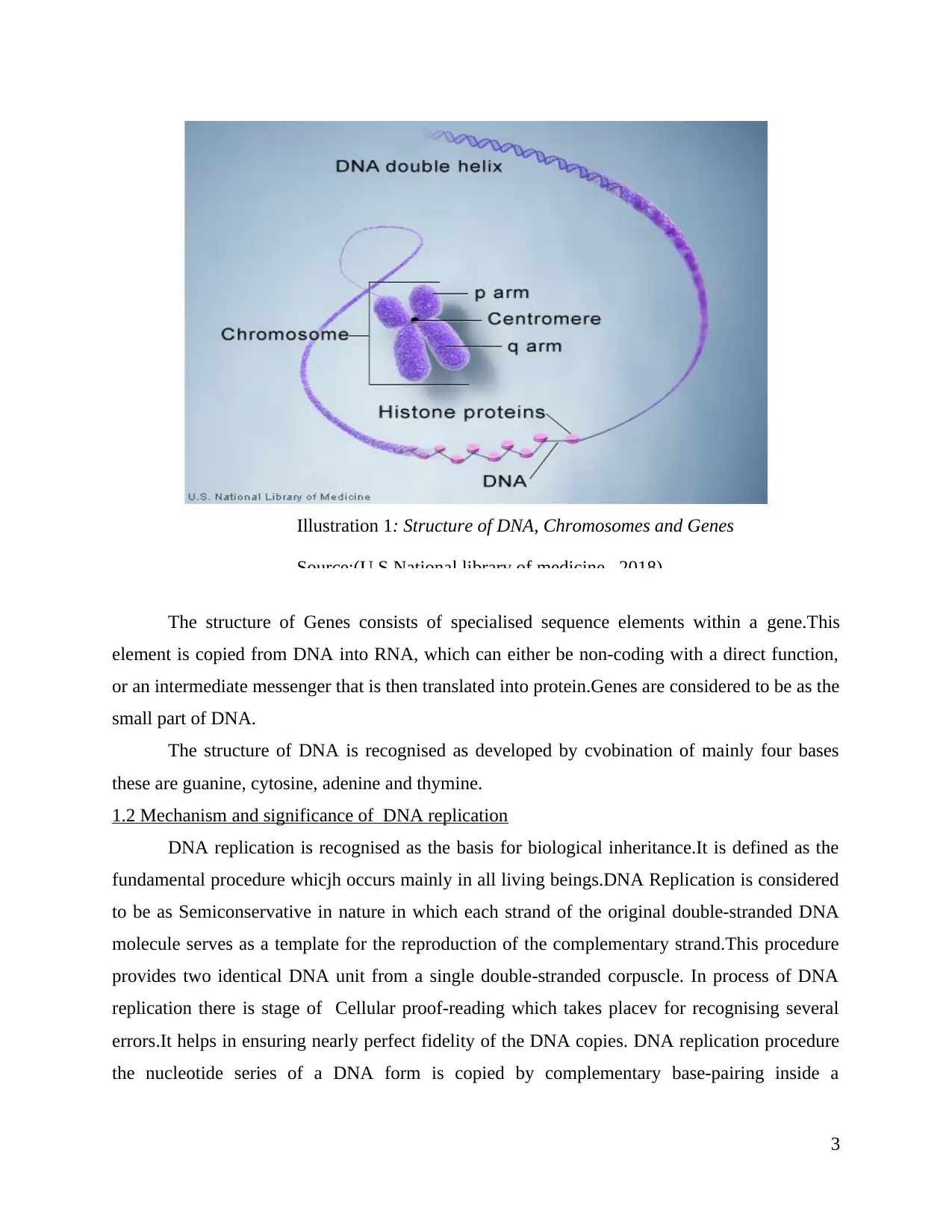
The structure of Genes consists of specialised sequence elements within a gene.This
element is copied from DNA into RNA, which can either be non-coding with a direct function,
or an intermediate messenger that is then translated into protein.Genes are considered to be as the
small part of DNA.
The structure of DNA is recognised as developed by cvobination of mainly four bases
these are guanine, cytosine, adenine and thymine.
1.2 Mechanism and significance of DNA replication
DNA replication is recognised as the basis for biological inheritance.It is defined as the
fundamental procedure whicjh occurs mainly in all living beings.DNA Replication is considered
to be as Semiconservative in nature in which each strand of the original double-stranded DNA
molecule serves as a template for the reproduction of the complementary strand.This procedure
provides two identical DNA unit from a single double-stranded corpuscle. In process of DNA
replication there is stage of Cellular proof-reading which takes placev for recognising several
errors.It helps in ensuring nearly perfect fidelity of the DNA copies. DNA replication procedure
the nucleotide series of a DNA form is copied by complementary base-pairing inside a
3
Illustration 1: Structure of DNA, Chromosomes and Genes
Source:(U.S National library of medicine , 2018)
element is copied from DNA into RNA, which can either be non-coding with a direct function,
or an intermediate messenger that is then translated into protein.Genes are considered to be as the
small part of DNA.
The structure of DNA is recognised as developed by cvobination of mainly four bases
these are guanine, cytosine, adenine and thymine.
1.2 Mechanism and significance of DNA replication
DNA replication is recognised as the basis for biological inheritance.It is defined as the
fundamental procedure whicjh occurs mainly in all living beings.DNA Replication is considered
to be as Semiconservative in nature in which each strand of the original double-stranded DNA
molecule serves as a template for the reproduction of the complementary strand.This procedure
provides two identical DNA unit from a single double-stranded corpuscle. In process of DNA
replication there is stage of Cellular proof-reading which takes placev for recognising several
errors.It helps in ensuring nearly perfect fidelity of the DNA copies. DNA replication procedure
the nucleotide series of a DNA form is copied by complementary base-pairing inside a
3
Illustration 1: Structure of DNA, Chromosomes and Genes
Source:(U.S National library of medicine , 2018)
Paraphrase This Document
Need a fresh take? Get an instant paraphrase of this document with our AI Paraphraser
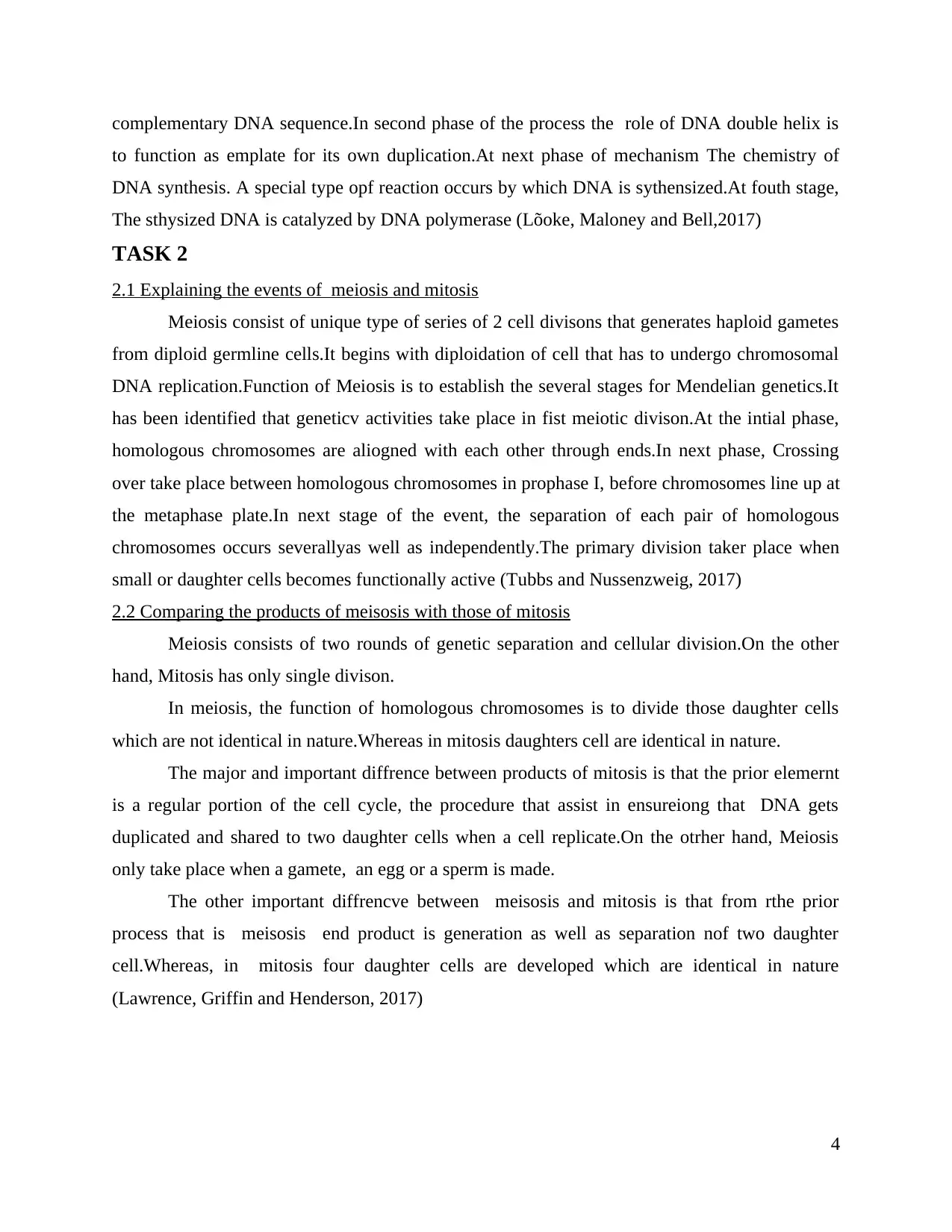
complementary DNA sequence.In second phase of the process the role of DNA double helix is
to function as emplate for its own duplication.At next phase of mechanism The chemistry of
DNA synthesis. A special type opf reaction occurs by which DNA is sythensized.At fouth stage,
The sthysized DNA is catalyzed by DNA polymerase (Lõoke, Maloney and Bell,2017)
TASK 2
2.1 Explaining the events of meiosis and mitosis
Meiosis consist of unique type of series of 2 cell divisons that generates haploid gametes
from diploid germline cells.It begins with diploidation of cell that has to undergo chromosomal
DNA replication.Function of Meiosis is to establish the several stages for Mendelian genetics.It
has been identified that geneticv activities take place in fist meiotic divison.At the intial phase,
homologous chromosomes are aliogned with each other through ends.In next phase, Crossing
over take place between homologous chromosomes in prophase I, before chromosomes line up at
the metaphase plate.In next stage of the event, the separation of each pair of homologous
chromosomes occurs severallyas well as independently.The primary division taker place when
small or daughter cells becomes functionally active (Tubbs and Nussenzweig, 2017)
2.2 Comparing the products of meisosis with those of mitosis
Meiosis consists of two rounds of genetic separation and cellular division.On the other
hand, Mitosis has only single divison.
In meiosis, the function of homologous chromosomes is to divide those daughter cells
which are not identical in nature.Whereas in mitosis daughters cell are identical in nature.
The major and important diffrence between products of mitosis is that the prior elemernt
is a regular portion of the cell cycle, the procedure that assist in ensureiong that DNA gets
duplicated and shared to two daughter cells when a cell replicate.On the otrher hand, Meiosis
only take place when a gamete, an egg or a sperm is made.
The other important diffrencve between meisosis and mitosis is that from rthe prior
process that is meisosis end product is generation as well as separation nof two daughter
cell.Whereas, in mitosis four daughter cells are developed which are identical in nature
(Lawrence, Griffin and Henderson, 2017)
4
to function as emplate for its own duplication.At next phase of mechanism The chemistry of
DNA synthesis. A special type opf reaction occurs by which DNA is sythensized.At fouth stage,
The sthysized DNA is catalyzed by DNA polymerase (Lõoke, Maloney and Bell,2017)
TASK 2
2.1 Explaining the events of meiosis and mitosis
Meiosis consist of unique type of series of 2 cell divisons that generates haploid gametes
from diploid germline cells.It begins with diploidation of cell that has to undergo chromosomal
DNA replication.Function of Meiosis is to establish the several stages for Mendelian genetics.It
has been identified that geneticv activities take place in fist meiotic divison.At the intial phase,
homologous chromosomes are aliogned with each other through ends.In next phase, Crossing
over take place between homologous chromosomes in prophase I, before chromosomes line up at
the metaphase plate.In next stage of the event, the separation of each pair of homologous
chromosomes occurs severallyas well as independently.The primary division taker place when
small or daughter cells becomes functionally active (Tubbs and Nussenzweig, 2017)
2.2 Comparing the products of meisosis with those of mitosis
Meiosis consists of two rounds of genetic separation and cellular division.On the other
hand, Mitosis has only single divison.
In meiosis, the function of homologous chromosomes is to divide those daughter cells
which are not identical in nature.Whereas in mitosis daughters cell are identical in nature.
The major and important diffrence between products of mitosis is that the prior elemernt
is a regular portion of the cell cycle, the procedure that assist in ensureiong that DNA gets
duplicated and shared to two daughter cells when a cell replicate.On the otrher hand, Meiosis
only take place when a gamete, an egg or a sperm is made.
The other important diffrencve between meisosis and mitosis is that from rthe prior
process that is meisosis end product is generation as well as separation nof two daughter
cell.Whereas, in mitosis four daughter cells are developed which are identical in nature
(Lawrence, Griffin and Henderson, 2017)
4
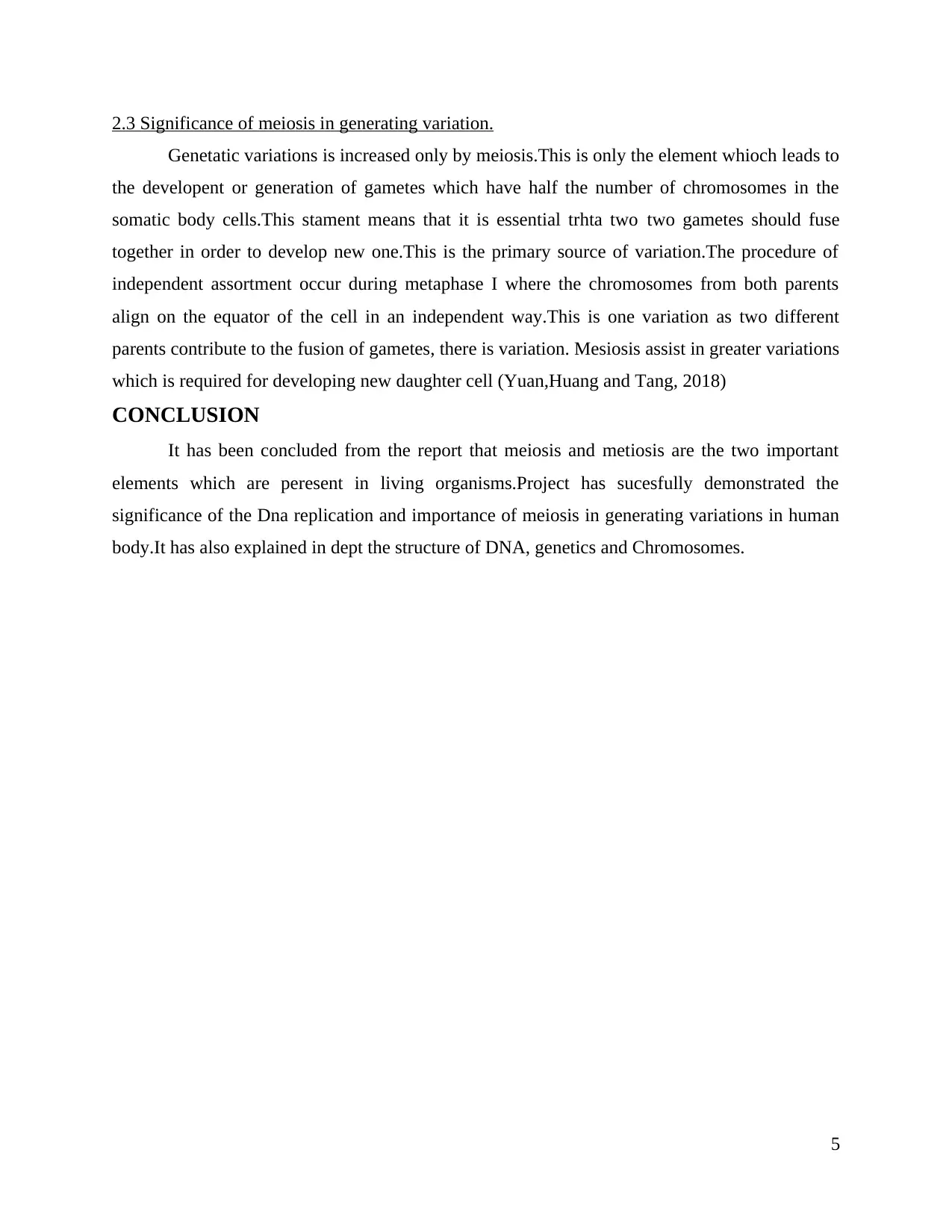
2.3 Significance of meiosis in generating variation.
Genetatic variations is increased only by meiosis.This is only the element whioch leads to
the developent or generation of gametes which have half the number of chromosomes in the
somatic body cells.This stament means that it is essential trhta two two gametes should fuse
together in order to develop new one.This is the primary source of variation.The procedure of
independent assortment occur during metaphase I where the chromosomes from both parents
align on the equator of the cell in an independent way.This is one variation as two different
parents contribute to the fusion of gametes, there is variation. Mesiosis assist in greater variations
which is required for developing new daughter cell (Yuan,Huang and Tang, 2018)
CONCLUSION
It has been concluded from the report that meiosis and metiosis are the two important
elements which are peresent in living organisms.Project has sucesfully demonstrated the
significance of the Dna replication and importance of meiosis in generating variations in human
body.It has also explained in dept the structure of DNA, genetics and Chromosomes.
5
Genetatic variations is increased only by meiosis.This is only the element whioch leads to
the developent or generation of gametes which have half the number of chromosomes in the
somatic body cells.This stament means that it is essential trhta two two gametes should fuse
together in order to develop new one.This is the primary source of variation.The procedure of
independent assortment occur during metaphase I where the chromosomes from both parents
align on the equator of the cell in an independent way.This is one variation as two different
parents contribute to the fusion of gametes, there is variation. Mesiosis assist in greater variations
which is required for developing new daughter cell (Yuan,Huang and Tang, 2018)
CONCLUSION
It has been concluded from the report that meiosis and metiosis are the two important
elements which are peresent in living organisms.Project has sucesfully demonstrated the
significance of the Dna replication and importance of meiosis in generating variations in human
body.It has also explained in dept the structure of DNA, genetics and Chromosomes.
5
⊘ This is a preview!⊘
Do you want full access?
Subscribe today to unlock all pages.

Trusted by 1+ million students worldwide
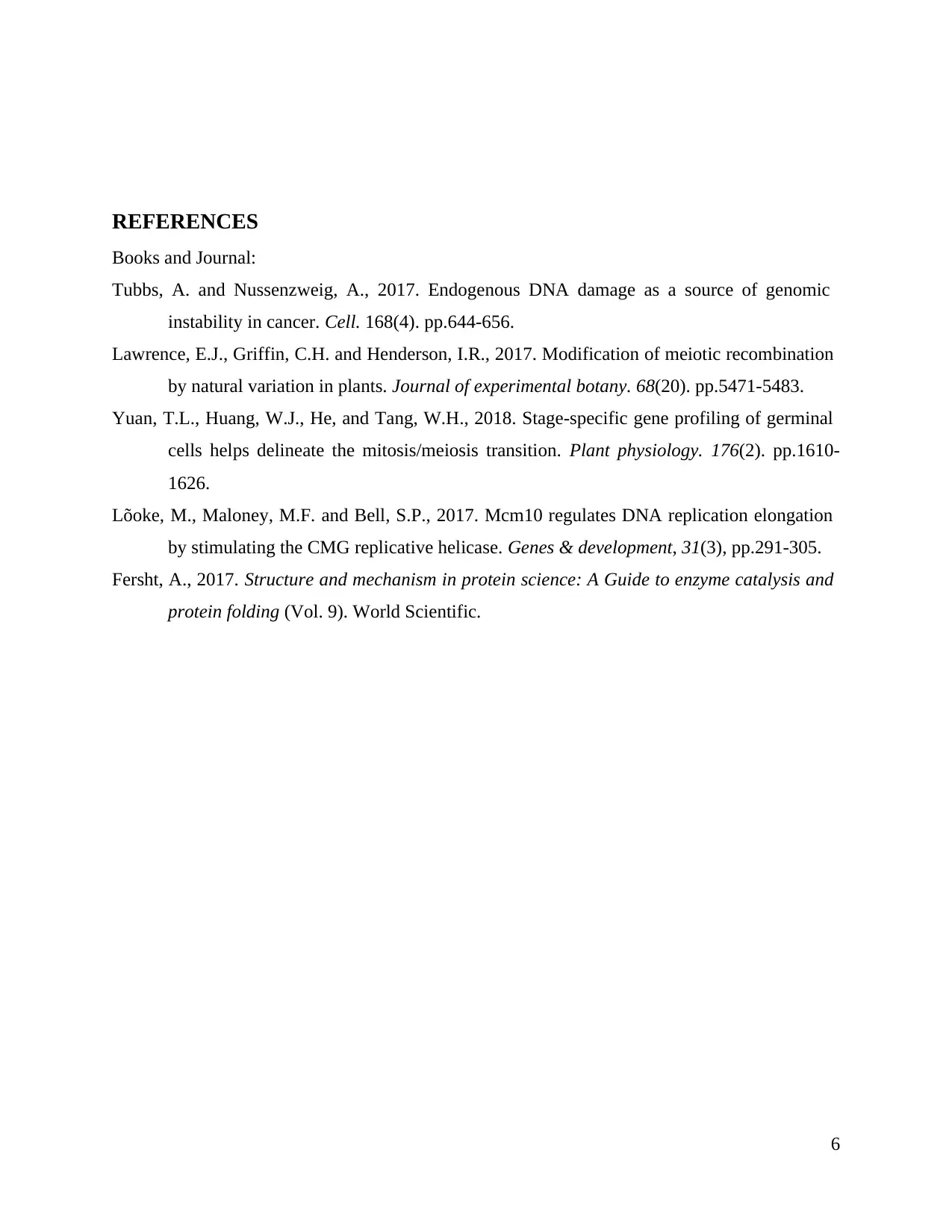
REFERENCES
Books and Journal:
Tubbs, A. and Nussenzweig, A., 2017. Endogenous DNA damage as a source of genomic
instability in cancer. Cell. 168(4). pp.644-656.
Lawrence, E.J., Griffin, C.H. and Henderson, I.R., 2017. Modification of meiotic recombination
by natural variation in plants. Journal of experimental botany. 68(20). pp.5471-5483.
Yuan, T.L., Huang, W.J., He, and Tang, W.H., 2018. Stage-specific gene profiling of germinal
cells helps delineate the mitosis/meiosis transition. Plant physiology. 176(2). pp.1610-
1626.
Lõoke, M., Maloney, M.F. and Bell, S.P., 2017. Mcm10 regulates DNA replication elongation
by stimulating the CMG replicative helicase. Genes & development, 31(3), pp.291-305.
Fersht, A., 2017. Structure and mechanism in protein science: A Guide to enzyme catalysis and
protein folding (Vol. 9). World Scientific.
6
Books and Journal:
Tubbs, A. and Nussenzweig, A., 2017. Endogenous DNA damage as a source of genomic
instability in cancer. Cell. 168(4). pp.644-656.
Lawrence, E.J., Griffin, C.H. and Henderson, I.R., 2017. Modification of meiotic recombination
by natural variation in plants. Journal of experimental botany. 68(20). pp.5471-5483.
Yuan, T.L., Huang, W.J., He, and Tang, W.H., 2018. Stage-specific gene profiling of germinal
cells helps delineate the mitosis/meiosis transition. Plant physiology. 176(2). pp.1610-
1626.
Lõoke, M., Maloney, M.F. and Bell, S.P., 2017. Mcm10 regulates DNA replication elongation
by stimulating the CMG replicative helicase. Genes & development, 31(3), pp.291-305.
Fersht, A., 2017. Structure and mechanism in protein science: A Guide to enzyme catalysis and
protein folding (Vol. 9). World Scientific.
6
1 out of 7
Related Documents
Your All-in-One AI-Powered Toolkit for Academic Success.
+13062052269
info@desklib.com
Available 24*7 on WhatsApp / Email
![[object Object]](/_next/static/media/star-bottom.7253800d.svg)
Unlock your academic potential
Copyright © 2020–2025 A2Z Services. All Rights Reserved. Developed and managed by ZUCOL.





